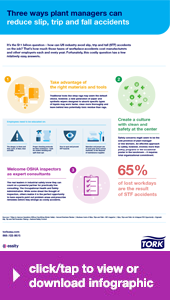It’s the $11 billion question – how can US industry avoid slip, trip and fall (STF) accidents on the job? That’s how much those types of workplace accidents cost manufacturers and other employers each and every year. Fortunately, this costly question has a few relatively easy answers.
One: Take advantage of the right materials and tools
Smart investment in preventing STFs starts with tailoring the choice of materials and tools to exact tasks. For instance, while traditional tools like shop rags may seem the default choice given their years of use, newer, more task-specific options are available. A new generation of paper and synthetic wipers designed to absorb specific types of liquids may work faster, clean more thoroughly and leave behind less potentially-toxic residue than rags.
Two: Create a culture with clean and safety at the center
 Invest in safety and cleaning protocols that keep your employee’s health and well-being top of mind. An analysis of research on STF injuries by the National Institute of Occupational Safety and Health concluded, “Preventing STF accidents is a ripe opportunity for a significant return on investment (ROI).” That’s no wonder, considering that STF accidents account for 65 percent of lost workdays.
Invest in safety and cleaning protocols that keep your employee’s health and well-being top of mind. An analysis of research on STF injuries by the National Institute of Occupational Safety and Health concluded, “Preventing STF accidents is a ripe opportunity for a significant return on investment (ROI).” That’s no wonder, considering that STF accidents account for 65 percent of lost workdays.
Safety concerns, particularly those as seemingly “simple” as preventing STF, might seem to be the sole province of plant manager or line workers. An effective approach to safety, however, involves more than policy, programs or the occasional poster in the lunchroom – it requires total organizational commitment.
Three: Safety starts at the top
According to David Michaels, a former Assistant Secretary of Labor, safety starts at the top. He says, “From the CEO down, the message should be, “We care about safety because we care about you — doing it right means no one gets hurt.” But leadership demands more than corner-office platitudes. Michaels, writing in the Harvard Business Review, counsels that “Corporate leaders need to be familiar with the nature, extent, and potential of the major risks — and the risk mitigation plans — associated with their facilities.”
Executive vision ultimately has to come to life on the production floor, and that requires employee training, engagement via rewards, and on-going communication. First, employees need to be educated on:
- The danger, to them and their work, of slips, trips and falls
- How to spot and prevent STF hazards
- Proper cleaning protocols for their workspace – both for routine cleaning and
spill clean-ups - How to select and use proper work gear, from correct shoes, to the correct materials to use for specific tasks, to the proper disposal of maintenance supplies
If you don’t have a training program in place, you can turn to third parties such as the National Safety Council, to take advantage of their pre-packaged safety training courses.
Once training is in place, incentives should be offered for all employees to participate – and managers should have safety records connected to their performance reviews, with rewards for low levels of safety incidents. All of these factors should be featured in on-going communications, whether in team meetings or featured in posters throughout a facility.
Four: Welcome OSHA inspectors as expert consultants
Finally, the real leaders in industrial safety know they can count on a powerful partner for practically free consulting: The Occupational Health and Safety Administration, OHSA. While some dread the thought of inspection, others realize it is the perfect opportunity to have experts point out problem areas and prescribe remedies before they emerge as costly accidents. In fact, one study showed that companies were saving as much as $350,000 per OHSA inspection.
Given the average STF incident costs an employer $20,000, and the defense of an STF claims costs $50,000, now is the time to make sure your organization isn’t slipping up on safety.
Sources:
Harvard Business Review: 7 Ways to Improve Operations Without Sacrificing Worker Safety
BIC magazine: Business Costs of Slips, Trips and Falls
Ergoweb: Slips, Trips and Falls: An Untapped ROI Opportunity
National Safety Council: Slip, Trip and Fall Prevention Training
